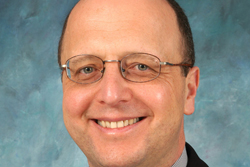 |
Pierre Fayad, M.D. |
The award recognizes the medical center’s successful commitment to implement a higher standard of stroke care by ensuring that stroke patients receive treatment for at least 24 months according to nationally accepted standards and recommendations.
The Nebraska Medical Center was recognized by the American Stroke Association in an advertisement in the July 21 “America’s Best Hospitals” issue of US News & World Report.
“This accomplishment signifies that The Nebraska Medical Center has consistently committed to and successfully implemented accepted standards, or guidelines, to improve quality patient care,” said Pierre Fayad, M.D., director of the Stroke Center at The Nebraska Medical Center and Reynolds Centennial Professor and chairman of neurological sciences at UNMC. “Rapid assessment, treatment and intensive acute care is vital for stroke patients to help them gain back as much of their lives as possible and prevent complications.”
Medical center adheres to guidelines
To receive the Get With The Guidelines-Stroke Gold Performance Achievement Award, The Nebraska Medical Center demonstrated 85 percent adherence in the Get With The Guidelines-Stroke key measures for 24 or more consecutive months. These include aggressive use of medications such as:
- tPA;
- Antithrombotics;
- Anticoagulation therapy;
- DVT prophylaxis;
- Cholesterol-reducing drugs; and
- Smoking cessation.
|
“With a stroke, time lost is brain lost,” he said.
System allows for rapid diagnosis
The Nebraska Medical Center has developed a comprehensive system for rapid diagnosis and treatment of stroke patients admitted through the emergency department or transferred from other hospitals.
The medical center ensures the prompt availability and coordination of medical professionals, personnel and equipment 24 hours a day, seven days a week.
Highlights of its expertise include:
- Rapid brain and blood vessel imaging;
- Neurologists, neurosurgeons, emergency physicians, radiologists and pharmacists available to conduct acute patient evaluations; and
- Use of clot-busting medications and interventional clot removal techniques when appropriate.
“The American Stroke Association commends The Nebraska Medical Center for its success in implementing standards of care and protocols,” said Lee Schwamm, M.D., chairman of the national Get With the Guidelines Steering Committee and vice-chairman of the neurology department and director of acute stroke services at Massachusetts General Hospital in Boston. “The full implementation of acute care and secondary prevention recommendations and guidelines is a critical step in saving the lives and improving outcomes of stroke patients.”
The right time to teach
Get With The Guidelines-Stroke uses the “teachable moment,” the time soon after a patient has had a stroke, when they are most likely to listen to and follow their health care professionals’ guidance. Studies demonstrate that patients who are taught how to manage their risk factors while still in the hospital reduce their risk of a second heart attack or stroke.
Through Get With The Guidelines-Stroke, customized patient education materials are made available at the point of discharge, based on patients’ individual risk profiles. The take-away materials are written in an easy-to-understand format and are available in English and Spanish. In addition, the Get With The Guidelines Patient Management Tool* provides access to up-to-date cardiovascular and stroke science at the point of care.
Stroke facts
According to the American Stroke Association,
- Each year approximately 795,000 people suffer a stroke — 610,000 are first attacks and 185,000 are recurrent;
- Every 40 seconds, someone in the United States suffers from a stroke;
- Stroke accounts for one out of every 18 deaths in the United States; and
- The number of acute ischemic stroke patients eligible for treatment is expected to grow over the next decade due to increasing stroke incidence and a large aging population.